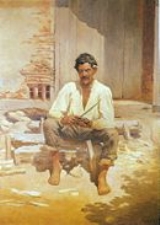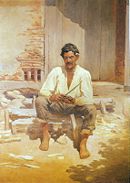
Caipira
Encyclopedia

Brazilian Portuguese
Brazilian Portuguese is a group of Portuguese dialects written and spoken by most of the 190 million inhabitants of Brazil and by a few million Brazilian emigrants, mainly in the United States, United Kingdom, Portugal, Canada, Japan and Paraguay....
term used to designate inhabitants of rural, remote areas of some Brazilian states—it refers to the people of lesser schooling. It can be considered pejorative when used to describe others, but it can also be used as a self-identifier without negative connotations. It often carries the connotation of an uneducated (at times naïve or even stupid) person, and someone who can't speak proper Portuguese. In festas juninas
Festa Junina
Festa Junina , also known as festa de São João for their part in celebrating the nativity of St. John the Baptist, are the annual Brazilian celebrations historically related to European Midsummer that take place in the beginning of the Brazilian winter...
it is traditional in some areas for people who are not considered as such to dress up as stereotypical Caipiras.
It is also used as a name for an accent or group of accents of Portuguese
Portuguese language
Portuguese is a Romance language that arose in the medieval Kingdom of Galicia, nowadays Galicia and Northern Portugal. The southern part of the Kingdom of Galicia became independent as the County of Portugal in 1095...
in the states of São Paulo
São Paulo (state)
São Paulo is a state in Brazil. It is the major industrial and economic powerhouse of the Brazilian economy. Named after Saint Paul, São Paulo has the largest population, industrial complex, and economic production in the country. It is the richest state in Brazil...
and neighboring areas in Mato Grosso do Sul
Mato Grosso do Sul
Mato Grosso do Sul is one of the states of Brazil.Neighboring Brazilian states are Mato Grosso, Goiás, Minas Gerais, São Paulo and Paraná. It also borders the countries of Paraguay and Bolivia to the west. The economy of the state is largely based on agriculture and cattle-raising...
, Goiás
Goiás
Goiás is a state of Brazil, located in the central part of the country. The name Goiás comes from the name of an indigenous community...
, the south of Minas Gerais
Minas Gerais
Minas Gerais is one of the 26 states of Brazil, of which it is the second most populous, the third richest, and the fourth largest in area. Minas Gerais is the Brazilian state with the largest number of Presidents of Brazil, the current one, Dilma Rousseff, being one of them. The capital is the...
, and part of Paraná
Paraná (state)
Paraná is one of the states of Brazil, located in the South of the country, bordered on the north by São Paulo state, on the east by the Atlantic Ocean, on the south by Santa Catarina state and the Misiones Province of Argentina, and on the west by Mato Grosso do Sul and the republic of Paraguay,...
. By extension, the term caipira can also be applied to the different cultural manifestations of the caipiras, such as their music
Music
Music is an art form whose medium is sound and silence. Its common elements are pitch , rhythm , dynamics, and the sonic qualities of timbre and texture...
. The diminutive
Diminutive
In language structure, a diminutive, or diminutive form , is a formation of a word used to convey a slight degree of the root meaning, smallness of the object or quality named, encapsulation, intimacy, or endearment...
form derived from the caipira noun, caipirinha
Caipirinha
Caipirinha is Brazil's national cocktail, made with cachaça , sugar and lime. Cachaça is Brazil's most common distilled alcoholic beverage . Both rum and cachaça are made from sugarcane-derived products...
, is known as a cocktail
Cocktail
A cocktail is an alcoholic mixed drink that contains two or more ingredients—at least one of the ingredients must be a spirit.Cocktails were originally a mixture of spirits, sugar, water, and bitters. The word has come to mean almost any mixed drink that contains alcohol...
worldwide.
Characteristics
Although the caipira accent originated in the state of São PauloSão Paulo (state)
São Paulo is a state in Brazil. It is the major industrial and economic powerhouse of the Brazilian economy. Named after Saint Paul, São Paulo has the largest population, industrial complex, and economic production in the country. It is the richest state in Brazil...
, the language of the state capital
São Paulo
São Paulo is the largest city in Brazil, the largest city in the southern hemisphere and South America, and the world's seventh largest city by population. The metropolis is anchor to the São Paulo metropolitan area, ranked as the second-most populous metropolitan area in the Americas and among...
is now a very different variety close to standard Portuguese, albeit with some remotely Italian-influenced elements. Caipira is spoken mostly in the countryside.
Phonetically, the most important differences in comparison with standard Brazilian Portuguese are the approximant [ɹ] for ⟨rr⟩, and the merger of ʎ (written ⟨lh⟩ in Portuguese) into the semivowel j. Coda
Syllable coda
In phonology, a syllable coda comprises the consonant sounds of a syllable that follow the nucleus, which is usually a vowel. The combination of a nucleus and a coda is called a rime. Some syllables consist only of a nucleus with no coda...
⟨l⟩ is frequently modified into ɹ, instead of the w used in most of Brazil. There are other important changes, as in the following examples:
| Standard Brazilian Portuguese | Caipira Portuguese | English | ||
|---|---|---|---|---|
| Spelling | Pronunciation (IPA International Phonetic Alphabet The International Phonetic Alphabet "The acronym 'IPA' strictly refers [...] to the 'International Phonetic Association'. But it is now such a common practice to use the acronym also to refer to the alphabet itself that resistance seems pedantic... ) |
Pronunciation spelling Pronunciation spelling A pronunciation spelling of a word is a spelling different from the standard spelling, used to emphasize a particular pronunciation of the word. The spelling uses the regular spelling rules of the language. Most are nonce coinages, but some have become standardised, e.g... |
Pronunciation (IPA) | |
| flor | [ˈfloʁ] | frô | [ˈfɾo] | flower |
| falso | [ˈfawsʊ] | farso | [ˈfaɹsʊ] | false |
| melhor | [meˈʎɔʁ] | mió | [miˈjɔ] | better |
| voar | [vʊˈaʁ] | avuá | [avʊˈa] | to fly |
| você | [voˈse] | ocê | [oˈse] | you |
| ganhamos | [ɡɐ̃ˈɲɐ̃mʊs] or [ɡɐ̃ˈɲɐ̃mʊʃ] | ganhemo | [ɡɐ̃ˈɲɛmʊ] | we won |
| voltamos | [vowˈtɐ̃mʊs] or [vowˈtɐ̃mʊʃ] | vortemo | [voɹˈtɛmʊ] | we came back |
| bêbado | [ˈbebadu] | beudo | [ˈbewdu] | drunk |
There are some significant differences in caipira morphology and syntax. For example:
- The negative adverb não has distinct strong and weak formsWeak form and strong formIn the phonology of stress-timed languages, the weak form of a word is a form that may be used when the word has no stress, and which is phonemically distinct from the strong form, used when the word is stressed. The strong form serves as the citation form or the isolation form when a word is...
, não [nɐ̃ʊ̯̃] in short replies, and num [nʊ̃] for negative phrases. - In plural forms only the article or pronoun is inflected, and the adjective often remains uninflected, e.g.: standard Portuguese: essas coisas bonitas [ˈɛsɐsˈkoizɐz bʊˈnitɐs] "those beautiful things" (those-PL beautiful-PL thing-PL) ↔ caipira: essas coisa bonita [ˈɛsɐsˈkoizɐ bʊˈnitɐ] (those-PL beautiful-∅ thing-∅).
Despite these differences, a speaker of standard Portuguese has no difficulty at all understanding caipira.
Like other Portuguese accents in Brazil, caipira is not and has never been considered a separate language. It has no tradition in literature, nor a definite standard for spelling and it is merely considered as a colloquial mode of Portuguese.
Non-standard orthography intended to convey Caipira pronunciation is featured prominently in the popular children's comic book Chico Bento
Chuck Billy 'n' Folks
Chuck Billy 'n' Folks are a group of fictional characters appearing at the Monica's Gang comic book series. The stories are centered on Chuck Billy and his friends and parents, who are all caipiras and live in the small Vila Abobrinha , a fictional location on the countryside of Brazil...
, in which some (but not all) characters speak in this dialect.
See also
- Brazilian PortugueseBrazilian PortugueseBrazilian Portuguese is a group of Portuguese dialects written and spoken by most of the 190 million inhabitants of Brazil and by a few million Brazilian emigrants, mainly in the United States, United Kingdom, Portugal, Canada, Japan and Paraguay....
- Portuguese dialectsPortuguese dialectsPortuguese dialects are variants of the Portuguese language that are shared by a substantial number of speakers over several generations, but are not sufficiently distinct from the official norms to be considered separate languages...
- Portuguese phonologyPortuguese phonologyThe phonology of Portuguese can vary considerably between dialects, in extreme cases leading to difficulties in intelligibility. This article focuses on the pronunciations that are generally regarded as standard...
- MineiroMineiroMineiro redirects here; for the Brazilian footballer nicknamed Mineiro, see Mineiro .Mineiro feminine: Mineira), also called Brazilian mountain dialect, is the Brazilian Portuguese term for the inhabitants of the Brazilian state of Minas Gerais and also the characteristic accent spoken in the...
- CariocaCariocaCarioca is a Portuguese adjective or demonym that is used to refer to the native inhabitants of the city of Rio de Janeiro - capital of the homonym state , in Brazil...
- CarcamanoCarcamanoCarcamano is an ethnic slur used in Southern Brazil for the descendants of the non-Iberian European immigrants who arrived in Brazil in the late 19th century and in the early 20th century....
- GaúchoGauchoGaucho is a term commonly used to describe residents of the South American pampas, chacos, or Patagonian grasslands, found principally in parts of Argentina, Uruguay, Southern Chile, and Southern Brazil...

